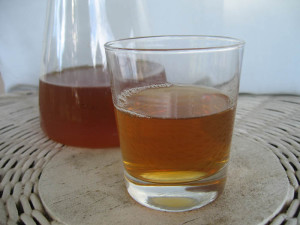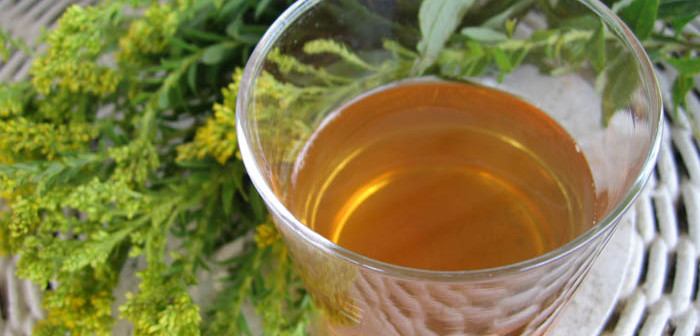Kombucha: It’s all over the specialty food shops and the health food sections of local grocery stores. For some, it’s a part of their culture and everyday lives, and for others it’s a miracle elixir that boosts health and even prolongs life. You can buy it bottled, but there’s no reason not to make your own. Basically, it’s an excuse to do science in your kitchen.
What Is Kombucha?
The beverage known as kombucha has been around almost as long as tea itself; it’s been enjoyed for centuries by people all over Asia, Russia, and Eastern Europe. Some believe it was first brewed for a Chinese emperor in the Third Century BCE, used as medicine by a Korean doctor in the Fifth Century CE, or discovered by a Tibetan monk long, long ago. Or it may, as some claim, have come from a galaxy far, far away — the jury’s still out on that one. No matter where it originated, there’s no doubt that kombucha is amazingly good for you, if not a little bit weird.
Russia, and Eastern Europe. Some believe it was first brewed for a Chinese emperor in the Third Century BCE, used as medicine by a Korean doctor in the Fifth Century CE, or discovered by a Tibetan monk long, long ago. Or it may, as some claim, have come from a galaxy far, far away — the jury’s still out on that one. No matter where it originated, there’s no doubt that kombucha is amazingly good for you, if not a little bit weird.
Simply put, kombucha is probiotic, fermented tea in the same category as yogurt and sauerkraut. This tasty beverage is full of vitamins, nutrients, and other beneficial goodies that will make your body dance with joy. How they get there, however, is where the science comes in.
You can’t just brew tea, let it sit, and end up with kombucha. Nope, sorry. Although tea is a vital ingredient, you won’t get anywhere unless you also have a SCOBY and some food for it.
A SCOBY — which is short for a symbiotic culture of bacteria and yeast — is a microbial organism that forms a sort of funky-looking patty on top of your fermenting tea, turning it from ordinary tea into a probiotic, good-for-you brew. It is often fondly, though erroneously, referred to as a “mushroom.” The thing about the SCOBY… it’ essentially, alive. And that means you have to feed it. No, it won’t eat your firstborn; SCOBYs, in fact, just adore sugar.
But, wait! I don’t like sugar in my tea! I’m diabetic! I’m watching my sugar consumption! Fear not, my friends. By the time your tea turns into kombucha, the SCOBY will have eaten up all the sugar, having used it to fuel the formation of beneficial nutrients in your tea.
Speaking of nutrients, there’s a long list of them in kombucha, from amino acids and B and C vitamins to a whole slew of beneficial bacteria and acids.
So what do all these great-sounding nutrients do for you? Results can vary from person to person, but it’s been reported that kombucha has helped with skin conditions, intestinal disorders, mood disorders, and autoimmune diseases. Many researchers believe it can fight cancer and reduce liver toxicity. Folks who drink kombucha regularly have been known for their glowing skin, healthy hair, and generally upbeat outlook on life.
How Do I Make This Stuff?
So you want to make your own kombucha. Right on! With just a few things — some of which are found right in your kitchen — you can be on your way to brewing bliss.
You’ll Need:
 Glass fermentation vessel (at least half gallon capacity)
Glass fermentation vessel (at least half gallon capacity)- Water
- Tea
- Sugar
- Temperature gauge
- SCOBY with starter liquid (distilled vinegar can replace starter liquid)
- Cotton cloth
- Rubber band
- Non-metallic mixing spoons and measuring cups
If you’re feeling a little uncertain about some of the materials — aren’t sure where on earth to find a SCOBY – Kombucha Brooklyn is an excellent resource. It’s all available on their website and can be shipped straight to your door. They even have pre-made starter kits that come with everything your little kombucha-brewing heart could desire.
Once you have everything gathered, you’re ready to start brewing! I’ll walk you through in my instructional video, but the steps are pretty easy.
The first task is one you’re already quite familiar with: making tea. You’ll want a strong brew because it’s going to be diluted. A general rule of thumb is to use six tea bags (or 13 grams of tea) steeped in four cups of water for each gallon your fermentation jar will hold. Since you’re making it extra strong, you’ll want to steep your tea for 15-20 minutes instead of the usual 3-5.
Once the tea is done add the sugar — 1 cup per quarter gallon of tea. Remember, the SCOBY will take care of eating the sugar and breaking it down into nutrients, so don’t worry about all that sweetener.
To recap, our basic formula so far is: 13 grams tea + 4 cups water + 1 cup sugar. If you remember that, you can scale up or down from there.
Now that you have a super sweet, super strong hot tea, you need to cool it down by adding cold water, otherwise you’ll kill your poor little SCOBY and won’t get any kombucha. You’ll need to add 10 cups of cold water to your tea before pouring the entire thing into your fermentation vessel.
That means our full formula is: 13 grams tea + 4 cups hot water + 1 cup sugar + 10 cups cold water.
The next step is very, very important: Check the temperature of your brew. I find a sticky thermometer on the outside of the fermentation vessel works best, but you can also use an instant read thermometer if you have one. Make sure the temperature of your tea does not exceed 90 degrees Fahrenheit! If it does, wait for it to cool down or, I can’t stress this enough, you’ll send your SCOBY to an early grave.
When you’re sure the tea is below 90 degrees, go ahead and add the starter liquid and SCOBY. If your SCOBY didn’t come with starter liquid, you can use a couple tablespoons of distilled white vinegar instead. Immediately cover the top of your vessel with the kitchen towel, securing it with the rubber band. This will keep out dirt as well as bugs like fruit flies while still allowing the SCOBY to breathe. Breathing is important; if it doesn’t happen, the built up gases can cause your SCOBY to suffocate or your vessel to explode (ask me how I know).
Now put that vessel of magical tea in a dry, dark place with a temperature between 72 and 82 degrees and let it ferment! Check on it once in a while, taste it to see how it’s doing. After anywhere from one to two weeks, and once the flavor is to your liking, you can bottle that glorious kombucha, pop it in your fridge and enjoy the tasty, healthy benefits.
Want even more in-depth knowledge? I highly recommend picking up a copy of “Kombucha! The Amazing Probiotic Tea that Cleanses, Heals, Energizes, and Detoxifies” by Eric and Jessica Childs. They’ll walk you through everything you could possibly need to know about brewing kombucha, from choosing and blending tea to bottling and secondary fermentation.
Now go, my friends: brew tea, ferment it, live long, and prosper. And don’t forget to feed your SCOBY.
Disclosure: The author was provided with a starter kit from Kombucha Brooklyn for purposes of this article.
Disclaimer: Never shake bottled kombucha. It will explode just like soda. Don’t say I didn’t warn you.
Note that this post was originally published in 2014




